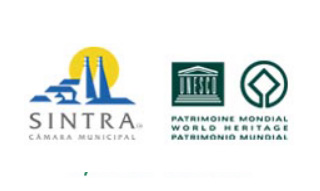The Royal Palace of Queluz, also called the National Palace of Queluz, was built in the 18th century.
One of the last great buildings in the Rococo style in Europe, it was built as a summer retreat for Prince D. Pedro of Bragança.
![]() The National Palace of Queluz was used as a discreet place of confinement for Queen D. Maria I while she was of infirm mind, especially after the death of D. Pedro in 1786. After the fire that attacked the Ajuda Palace in 1794, the Palace of Queluz became the official residence of the Prince Regent of Portugal, the future King D. João VI, and his family.
The royal family remained there until they fled to Brazil in 1807, due to the French invasions.
The building of the palace, designed by Mateus Vicente de Oliveira, began in 1747. Although much smaller, it is frequently called the Portuguese Versailles. After 1826, it gradually became less favoured by the Portuguese monarchs. After a severe fire in 1934, which destroyed the interior, the monument was extensively restored and is now open to the public
One of the wings of the Queluz Palace, the Dona Maria Pavilion, built between 1785 and 1792 and designed by Manuel Caetano de Sousa, is now a guest room for the exclusive use of foreign heads of state visiting Portugal.
It has been classified as a National Monument since 1910.
The National Palace of Queluz was used as a discreet place of confinement for Queen D. Maria I while she was of infirm mind, especially after the death of D. Pedro in 1786. After the fire that attacked the Ajuda Palace in 1794, the Palace of Queluz became the official residence of the Prince Regent of Portugal, the future King D. João VI, and his family.
The royal family remained there until they fled to Brazil in 1807, due to the French invasions.
The building of the palace, designed by Mateus Vicente de Oliveira, began in 1747. Although much smaller, it is frequently called the Portuguese Versailles. After 1826, it gradually became less favoured by the Portuguese monarchs. After a severe fire in 1934, which destroyed the interior, the monument was extensively restored and is now open to the public
One of the wings of the Queluz Palace, the Dona Maria Pavilion, built between 1785 and 1792 and designed by Manuel Caetano de Sousa, is now a guest room for the exclusive use of foreign heads of state visiting Portugal.
It has been classified as a National Monument since 1910.
http://www.sintraromantica.net/en/monuments/national-palace-of-queluz#sigFreeId3867103acd
Close to both Sintra and Lisbon, the National Palace of Queluz and its historical gardens are one of the most remarkable examples of the harmonious link between landscape and palatial architecture in Portugal. They illustrate the environment and lifestyle which the Royal Family and the Portuguese Court enjoyed in the second half of the 18th century and the early 19th century, while, at the same time, showing how tastes developed in this period marked by the baroque, rococo and neoclassicism, directing our attention to moments of great historical relevance, in the transition from the Ancien Régime to Liberalism.
From Castelo Rodrigo to the Casa do Infantado
Lying at the origin of the palace itself is the former Casa de Campo de Queluz, a summer retreat that was built by Cristóvão de Moura, the first Marquis of Castelo Rodrigo, who helped the Spanish Crown in the annexation of Portugal and its overseas territories. Manuel de Moura (1592-1652), his son and the second Marquis of Castelo Rodrigo, transformed the mansion into a large recreational estate, which was confiscated after the restoration of Portuguese independence from Spain in 1640 and given to Prince Pedro, the first Lord of the Casa do Infantado and the future King Pedro II (1648-1706).
The Casa do Infantado was a seigniory created in 1654 by King João IV (1604-1656) for the second-born sons of the Portuguese monarchs, the princes who were destined not to be the heirs to the Crown, thus enabling them to have their own property and income.
Prince Francisco (1691-1742), the second Lord of the Casa do Infantado, was responsible for the estate’s enlargement and for the catchment of water, including the building of the aqueduct that can still be seen there today. It was, however, Prince Pedro (1717-1786), the third Lord of the Casa do Infantado and the future King Consort Pedro III (through his marriage to his niece Queen Maria I), who, from 1747 to 1786, undertook a concerted campaign of building work, enlarging the so-called “Paço Velho” (Old Palace) and giving it the dimensions of a genuine Royal Palace. Remaining aloof to the political intrigues of the court, and endowed with his own considerable fortune and elegant habits and tastes, Pedro devoted his constant attention to Queluz in a direct involvement that only ended with his death.
From a Summer Retreat to a Royal Palace
Initially conceived as a summer residence, Queluz became the royal family’s preferred place for their leisure and entertainment. They lived there permanently from 1794 until their departure for Brazil in 1807, at the time of the French invasions. The different green spaces form a unified whole with the building itself, whose façades face the upper “French-style” gardens (the Hanging Garden and the Malta Garden) and are then prolonged through the delicate parterres de broderie delineated by box-tree hedges. The statues are inspired by themes from classical mythology and they decorate and mark out the main axes of these ornamental gardens. The remarkable group of stone and lead sculptures were brought from Italy and England, the latter being the work of the London-based artist John Cheere. These gardens are separated from the adjacent gardens, as well as from the surrounding farming land and wooded areas, by stone balustrades with flower pots and statues. A series of avenues irradiate from the portico, and these in turn are linked to others, forming a complex geometrical grid that has lakes and fountains with water features placed at its intersections. Particularly impressive among the various highlights is the Medallions Lake, designed in 1764 by the French architect Jean-Baptiste Robillion, which has the shape of an octagonal star.
Inside the palace, the state rooms, spaces used for religious worship and private apartments follow on from one another, all of them enjoying close links to the gardens outside, which were formerly used for festivities, dances, theatrical performances, concerts, games, and equestrian and firework displays. The gilded woodcarvings and papier maché work, the walls lined with mirrors or paintings and the sparkling and highly decorative chandeliers, as well as the various art works and other treasures on display (most of them originating from royal collections), all reflect the sophisticated atmosphere of the Palace’s golden age.
The scenographic Lions Staircase leads to the monumental Tiled Canal, a long artificial lake – decorated with large panels of glazed tiles depicting sea ports and chivalrous scenes – where the members of the Royal Family could ride in gondolas while listening to music.
The main building phases
The first building phase, directed by the architect of the Casa do Infantado Mateus Vicente de Oliveira (from c. 1747 to c. 1758), centred above all on adapting the former palace. This was then followed by a second phase that coincided with the announcement of the marriage of Prince Pedro to the heir to the throne, Princess Maria, which took place in 1760. It then became necessary to endow the Palace with stately spaces that were suitable for a royal residence, and an important role was played here by the architect and goldsmith Jean-Baptiste Robillion (from 1760 to 1782), under the supervision of Mateus Vicente de Oliveira. An example of this is the building, at the end of the 1760s, of the Throne Hall, which did not exist in the original plan, and the pavilion of private chambers, whose staircase links the Palace to the Royal Estate of Queluz, creating a highly elegant and scenographic effect.
In 1784, a new series of building works began, directed by the architect and sergeant-major Manuel Caetano de Sousa (from c. 1784 to 1792). This phase brought changes to the second floor, with the building of new apartments, although all that now remains of this refurbishment are the state rooms above the Ceremonial Façade, and the so-called Queen Maria Pavilion, built on the site of the “Opera House”. Both of these building campaigns were completed in 1789.
After the fire at the Royal Complex of Ajuda, in 1794, where the Royal Family had been in permanent residence since the 1755 earthquake, the Palace of Queluz became the official residence of Queen Maria I – who had meanwhile become a widow – and subsequently of the Prince Regents João VI and Carlota Joaquina. It proved necessary to adapt some of the interior spaces and build some new buildings to house the Court, the Household Guards and the servants.
Sophistication and Festivities
During the first period when the Palace was lived in, corresponding to the period of residence of King Pedro III and Queen Maria I, there was great emphasis on recreation and entertainment. This meant that the various spaces had to be extremely versatile, being staged and decorated in keeping with the different functions and events that were held there, usually celebrations of religious festivals and royal birthdays and anniversaries.
The Court frequently came to Queluz to attend the serenades, jousts and firework displays, to mark the commemorations held in honour of St. John and St. Peter, in the month of June, and King Pedro III’s name day, on 5 July. Most of the celebrations were held in the gardens and included the erection of ephemeral architecture, fireworks, equestrian games and bullfights, on horseback or on foot, amongst other forms of entertainment, especially between 1752 and 1786. At all these celebrations, music always played a central role.
Court life in Queluz became even livelier in the time when the betrothed of Prince João (the future King João VI) – the Spanish Princess Carlota Joaquina of Bourbon – arrived in Portugal (1785), a period that also marked the epilogue of a carefree and happy time that would soon be darkened by a succession of tragic events.
The End of Splendour and of the Ancien Régime
The death of King Pedro III, in 1786, was followed two years later by the premature death of the heir to the throne, Prince José. He left behind him a mother who was extremely weak and her incapacity to govern was finally decreed in 1792, the year when Prince João was acclaimed Prince Regent.
The Royal Family made a hasty retreat to Brazil in 1807, one day before Napoleon’s troops finally entered Lisbon under the command of General Junot, and this brought an end to the liveliest period of residence at the Palace. A large part of the nobility departed with the Royal family, so that many national treasures were also removed from the country, including a great deal of the Palace’s contents.
In December 1807, Junot himself visited the Palace with the aim of introducing some changes to the building, which further fuelled the dream that Napoleon Bonaparte might one day take up residence there.
King João VI and the Portuguese Court returned to Portugal in 1821, but Queluz only came to be inhabited once more, under a regime of semi-exile, by Queen Carlota Joaquina, accompanied by her sister-in-law Princess Maria Francisca Benedita (1746-1829), the “Widow Princess”, whose name was to become linked to one of the wings of apartments. King Miguel (1802-1866) also lived in the Palace of Queluz, during the bloody and fratricidal wars that he waged with his brother Pedro IV (1798-1834), the first Emperor of Brazil and the first Portuguese constitutional monarch, who immediately after the liberal victory, died here prematurely as a victim of tuberculosis, in the same room – the Don Quixote Room – where he had been born 36 years earlier.
After 1957, the Queen Maria Pavilion, the east wing annexed to the Palace, began to be used as the residence for foreign Heads of State during official visits to Portugal.
The Portuguese School of Equestrian Art, founded in 1979, was housed in the Gardens of the National Palace of Queluz, with the aim of upholding the teaching, practice and promotion of the traditional Portuguese equestrian art. It seeks to continue the traditions of the Real Picaria, the equestrian academy of the Portuguese Court in the 18th century, and uses only Lusitano horses bred at the Alter Real Stud Farm.
Visitors to the Palace and Gardens can see a display with the horses and riders from the Portuguese School of Equestrian Art at 11.00 every Wednesday and Saturday.
The National Palace of Queluz was designated a National Monument in 1910 and has been a member of the Network of European Royal Residences since 2013.
Opening Hours and entrance fees:
PALACE
October 26th - February 28th: 9 a.m. - 5.30 p.m (last admission: 5 p.m.)
Price low season: € 8,50
March 1st - October 25th: 9 a.m. - 7 p.m. (last admission: 6 p.m.)
Price high season: € 9,00
GARDENS
October 26th - February 28th: 9 a.m. - 5.30 p.m (last admission: 5 p.m.)
Price low season: € 3,50
March 1st - October 25th: 9 a.m. - 7 p.m. (last admission: 6 p.m.)
Price high season: € 4,00
FALCONRY
http://www.parquesdesintra.pt/experiencias-e-lazer/falcoaria/
THE COURT AT QUELUZ: A VOYAGE TO THE DAILY LIFE IN THE 18th CENTURY
DESCRIPTION
Tiptoeing through the Palace we visit every corner of Queluz, listening to narratives of events in its history, meeting people from a different time, and dancing to 18th century songs and music. This visit focuses mainly on the grand parties, the dresses and other attires that were worn in that era of great beauty and refinement. Among other things, visitors will also learn that the princes did not attend school but had many subjects to learn. And many other surprises wait…
MEETING POINT
Ticket office
AUDIENCE
Recommended for children aged 5 to 12
DURATION
2:00h
DATES
to be scheduled
TIME
to be scheduled
PRICE
8 euros/participant
ADDITIONAL INFORMATION
Prior registration and payment required
The sessions require a minimum number of participants.
The sessions are not conditioned by the weather.
CONTACTS
comercial@parquesdesintra.pt ; + 351 21 923 73 00
APRESENTAÇÕES DA ESCOLA PORTUGUESA DE ARTE EQUESTRE
Largo do Palácio Nacional
2745-191 Queluz
Ph.: 21 434 38 60
Fax. 21 434 38 78
E-mail: pnqueluz@imc-ip.pt
pnqueluz.imc-ip.pt
Royal Palace of Queluz
38º 45’ 01,46” N
9º 15’ 28,40” W


 Português
Português
 English (UK)
English (UK)







